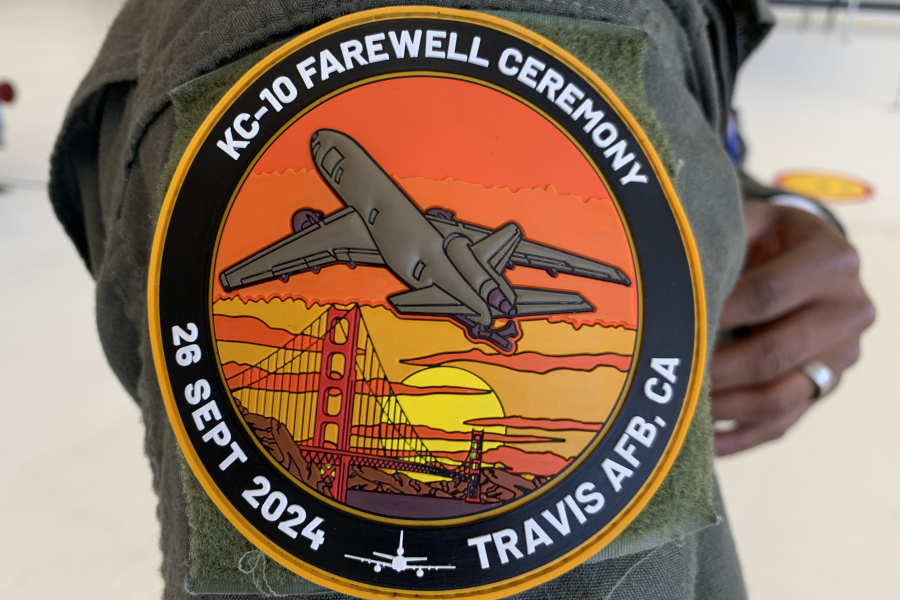TRAVIS AIR FORCE BASE, Calif.—Military aircraft are not known for fine dining, which is why several years ago Master Sgt. Van Stewart Jr. was surprised to wake up midway through a 19-hour flight to the Middle East aboard a KC-10 refueling tanker to the smell of roasted pork shoulder.
“I think they pre-roasted it, then brought it aboard and warmed it up,” the flight engineer recalled “It was delicious.”
Stewart’s story was one of many shared Sept. 25 and 26 here, as KC-10 Extender air and ground crew members past and present gathered to bid farewell to the last of the Air Force’s 60 KC-10s before its flight to the 309th Aerospace Maintenance and Regeneration Group, also known as The Boneyard, in Arizona.
The jet, tail number 79-1948, took off from Travis at about 10:15 a.m. Pacific Daylight Time on Sept. 26, flying under the callsign “Gucci 10,” an ode to the “Gucci” nickname and motto at the 9th Air Refueling Squadron, the last unit to operate the jet. The wheels-up was the last of thousands in the KC-10’s 44 years of service since it first took off in 1980. It was quickly joined by two F-15Cs from the California Air National Guard’s 144th Fighter Wing.
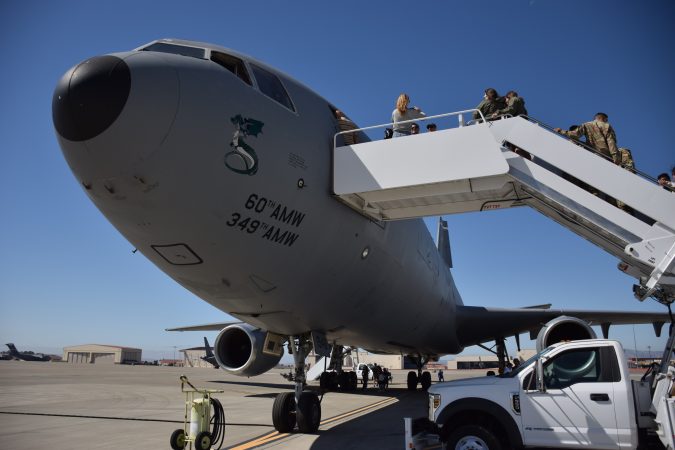
Also known as “Big Sexy,” the KC-10 can haul nearly twice as much gas as its older sibling, the KC-135, and almost as much cargo as the C-17, a dedicated transport jet. Retired Chief Master Sgt. Robert Lasseigne knew he was seeing something special when he joined the team testing the jet in 1980 in Yuma, Ariz.
A crew chief, Lasseigne had just come from the bumpier, colder C-130. By comparison, the KC-10 was literally an airliner; the jet was based on the McDonnell Douglas DC-10 and retained 88 percent systems commonality, according to the Air Force.
“The KC-10 was just great from a maintenance perspective,” Lasseigne told Air & Space Forces Magazine. “It was a good airplane, smooth rider, reliable, and it was very good at executing its mission.”
The crew chief recalled carrying all the spare parts, maintainers, and extra pilots for an F-15 squadron aboard three KC-10s while refueling the fighters from Holloman Air Force Base, N.M., on their way to a deployment overseas.
“When you do stuff like that, then you know what the total fight really is,” he said.
Stewart had a similar experience during his first mission on the KC-10.
“You hear the stories when you go through training, but then you actually execute the mission, and you see the amount of cargo we load on, and then you look out while you’re airborne, you see three fighters on both wings,” he said. “That’s who you’re dragging to wherever you need to get to.”
‘Never Once Let Me Down’
The KC-10’s vast fuel tanks paid off during the longest fighter combat mission in history. April 14, 1986, saw 24 F-111 strike fighters and five EF-111 electronic warfare variants take off from Royal Air Force Lakenheath, U.K., to strike targets in Libya in response to a terrorist attack on a Berlin discotheque that the U.S. and West Germany blamed on Libyan dictator Muammar Qaddafi.
The French and Spanish governments refused to allow U.S. aircraft to fly over their countries en route to the strike, so the fighters had to circle around much of the continent in a 6,400 mile, 13-hour trip, much longer than the standard F-111 sortie of about two hours.
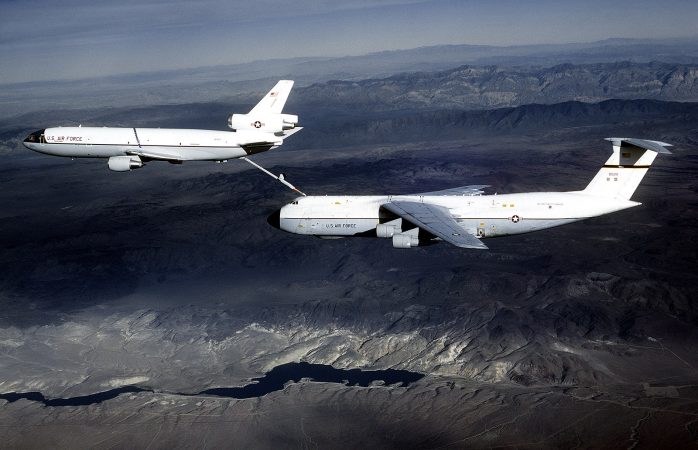
Operation El Dorado Canyon, as the mission became known, depended on nearly 30 KC-10 and KC-135 tankers refueling the fighters and each other multiple times there and back, often in radio silence. Senior Master Sgt. Kevin Danel remembered the briefing at RAF Mildenhall at 6 a.m. filled with tanker crews from across the service and a surprise appearance by then-Chief of Staff of the Air Force Gen. Charles Gabriel.
“That’s when I realized ‘we’re not kidding, this is serious,’” the now-retired KC-10 flight engineer recalled. “The Chief of Staff of the Air Force is here. We’re going to do it.”
Danel and the rest of his crew’s first job was to serve as backup in case a tanker broke down before the mission launched later that night. None of the jets malfunctioned, so their next job was to take off at around midnight and refuel the tankers on their way back from the Mediterranean Sea.
“One of the KC-10s just barely had enough fuel” to get to the rendezvous point because it had given so much to the F-111s en route, Danel said. The mission showcased the Extender’s “tremendous capability” he said. “It could carry so much more fuel, so it could do what it did.”
Lt. Col. Andrew Baer, commander of the 9th Air Refueling Squadron at Travis, described the amount of gas the KC-10 can haul as “staggering.”
“When we pull up to an exercise or to an event, and the controller says, ‘how much fuel do you have to give’ and you call back ‘300,000 [pounds],’ the radio stops,” he said. “People say, ‘what?’ It is just amazingly capable.”
That capability saved lives during the war in Afghanistan, where Baer filled up plenty of near-empty fighters so they could keep providing close air support for troops in contact.
“Even if that fighter started heading for home because he had to, we had the engines and speed to run him down, put the boom down, fill it up so he could turn around and come back,” Baer said. “Almost 4,000 hours in this plane, it has never once let me down.”
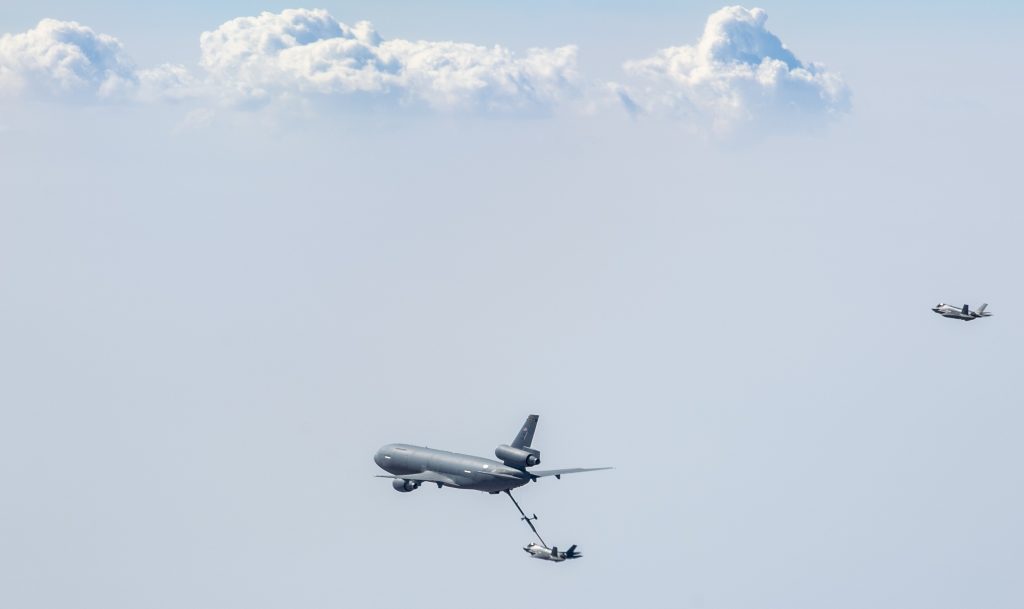
Fighter pilots shared that admiration.
“There are few better sights I’ve seen from the cockpit than the silhouette of the KC-10 on the horizon with its boom extended, and the relief I felt knowing I would soon get the fuel I needed to complete the mission,” said Chairman of the Joint Chiefs of Staff Gen. Charles Q. Brown Jr., an F-16 pilot, in a video statement played at the Sept. 26 ceremony.
But perhaps the most telling endorsement came from a KC-135 pilot, the new head of Air Mobility Command, Gen. John D. Lamontagne.
“There are tankers,” he said, raising one hand to eye level, “and then there are KC-10s,” raising the other hand above his head as far as he could go.
‘Well, This is a Nice Airplane’
The Extender also sported creature comforts including a coffee-maker, a refrigerator, and an oven, all of which were newer and nicer than the facilities aboard other aircraft such as the KC-135.
“Everybody else was envious of what we had, because there we were playing in an airliner,” said Danel, who considered the KC-10 “a big upgrade” over his previous aircraft, the C-141 Starlifter.
The fact that civilian airliners operated the DC-10 made for a collegial air crew culture, particularly in reserve units, said another flight engineer, retired Master Sgt. Michael Engelbrecht, better known by his nickname, “Commander Scumby.” On other aircraft, the commissioned pilots might not interact as much with the enlisted flight engineers, but on the KC-10, those flight engineers may soon be a fellow first officer or captain on the DC-10 at the airlines.
“A lot of these guys in the reserves, they were all airline pilots,” Engelbrecht said. “They knew that one day you could actually be sitting next to them if you got all your ratings. And then I became really good friends with a lot of the pilots.
“A lot of my buddies that are pilots at UPS or Hawaiian Airlines, they were flight engineers, because most of us said, ‘Well, this is a nice airplane, let’s do it for a living,’” he added.
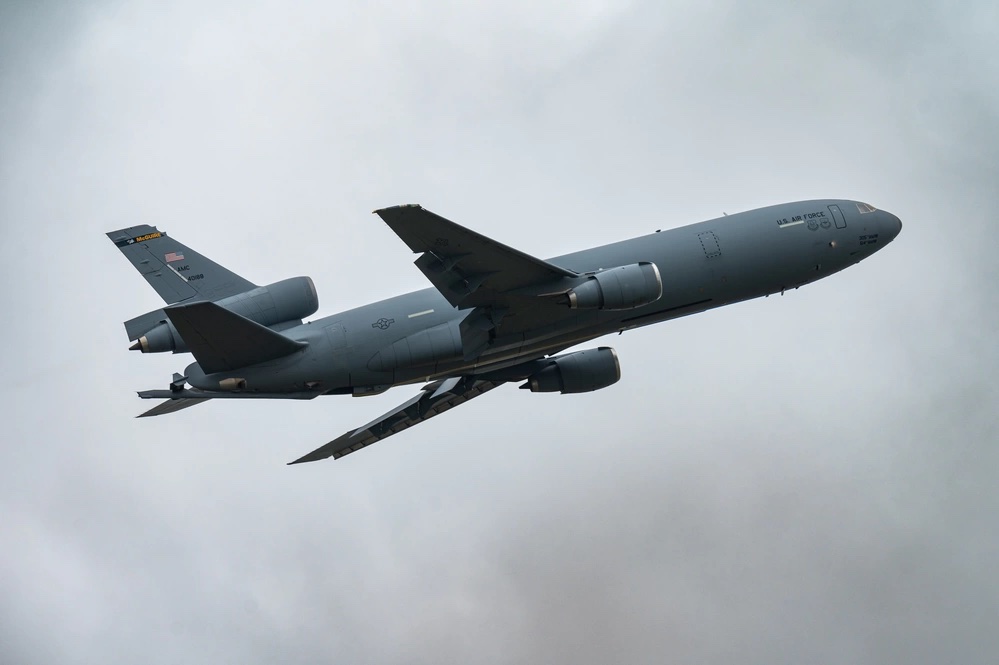
Along the way, the 9th Air Refueling Squadron picked up the term ‘Gucci’ as both a nickname and a way of life. Accounts differ as to where the term came from. Danel said it started when an Airman brought a Gucci brand carpet back from Honolulu to the squadron’s break area at March Air Force Base, Calif., where it was headquartered at the time. The squadron then became known as the “Gucci boys,” and used the callsign Gucci during airlift missions.
“Part of it too was because we had the nicest tanker,” he added. “It was so much nicer than the KC-135.”
Meanwhile, Stewart said the term originated when a group of squadron members went on a mission without any luggage, so they wound up buying Gucci brand luggage and hauling it around. Either way, “Gucci” has become a lifestyle at the 9th ARS.
“That’s like our motto: ‘Everything’s Gucci,’” Stewart said. “Whether it’s taking care of your Airmen or executing the mission, we just do it the Gucci way.”
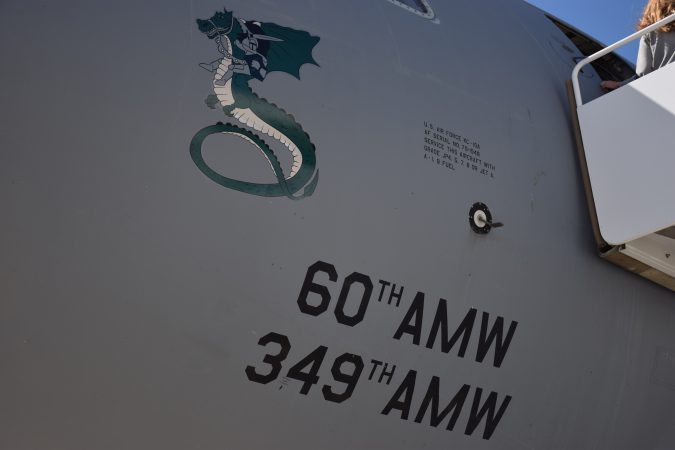
Generations United
That common identity between KC-10 crews past and present was on display at the farewell ceremony, where maintainers painstakingly recreated nose art on the final Extender of a knight riding a dragon. That nose art was spotted on the same tail number, 79-1948, back when it was originally delivered to Strategic Air Command, Baer explained.
“The nickname given to the airplane by the maintainers and the crews was Excalibur,” said the lieutenant colonel, who commanded the jet’s final flight.
Back in the SAC days, KC-10s sported a blue and white paint scheme. But the nose art reappeared in later images of the jet after it had been painted in a gray and white ‘Shamu’ paint scheme. Most nose art paint schemes are a one-off, Baer said, so the fact that the knight and dragon appeared twice made it a no-brainer for 79-1948’s final flight to the boneyard.
“Headquarters needs to approve nose art, and when we showed the history of how the nose art had been installed and reinstalled, it was a profound ‘yes,’” he said. “We’re really proud we put it right where it was, in the right scale, the right colors. It’s the real thing.”
But as great as the KC-10 was, the people who fixed and operated it were what made it special, Baer said.
“You saw generations from really the first delivery guys, the guys who were senior in 1980, all the way to some of our youngest Airmen out here shaking hands and meeting them,” he said of the ceremony. “That’s what is so incredible right now, in this one moment of time, we have multiple generations of people that are united by that airframe.”
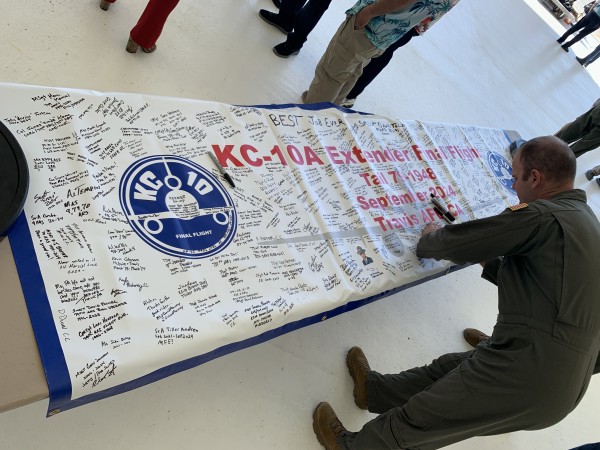
Those generations got to see the 79-1948 off when it climbed into the air for the last time on Sept. 26.
“I’m probably trying to hold it in because there’ll be so many people, but then when we get in the bus or get back home … it’s probably going to all come out,” said Stewart, the final KC-10 flight engineer, the day before the flight. “It’s going to be weird coming off the plane and not ever coming to pick it up.”
But while the KC-10 is retiring, the refueling mission continues as the the 9th ARS and other former KC-10 squadrons transition to the brand new KC-46 Pegasus, which Baer described as “a technological marvel.” It’ll be the latest tanker for the 9th, whose refueling history goes all the way back to 1951.
“Old Big Sexy is going away,” Stewart said, “but rest assured that the 9th Air Refueling Squadron and the other tanker squadrons, they’re still going to be bringing fuel to the fight in an upgraded capacity.”
